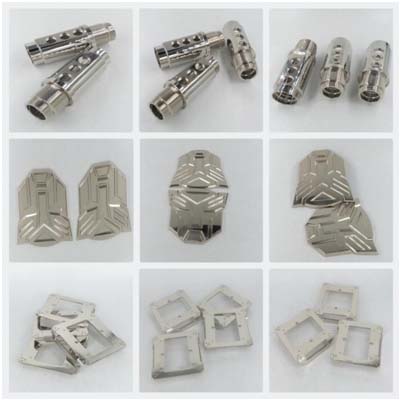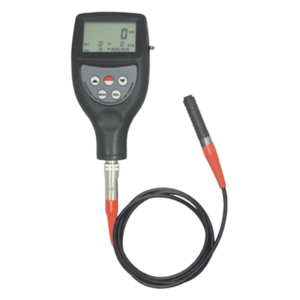Chemical Nickel Plating
Chemical Nickel Plating
Electroless nickel plating / chemical nickel plating / electroless nickel deposition.
Overview of One-stop Electroless Nickel Plating Processing Capabilities:
2.Workpiece dimensions: 0.1mm-1500mm (workpieces within 1.5 meters can be processed).
3.Coating thickness: 1μm-20μm.
Introduction to Electroless Nickel Plating Processing Technology.
Chemical nickel plating is used to improve corrosion resistance and wear resistance, increase gloss and aesthetics, and is suitable for bright nickel plating of small parts with complex shapes or tubes, without the need for polishing. The component to be plated is generally immersed in a mixed solution containing nickel sulfate, sodium dihydrogen phosphate, sodium acetate, and boric acid. Under certain acidity and temperature conditions, the nickel ions in the solution are reduced to atoms by sodium dihydrogen phosphate and deposited on the surface of the component, forming a fine and bright nickel coating. Steel components can be directly plated with nickel. Tin, copper, and copper alloys must be contacted with an aluminum sheet on their surface for 1-3 minutes to accelerate chemical nickel plating.
Classification of Chemical Nickel Plating:
According to the pH value of the plating solution, it can be classified into three categories: acidic, neutral, and alkaline.
According to the deposition temperature, it can be classified into three categories: low temperature, medium temperature, and high temperature.
According to the alloy composition, it can be classified into three categories: low-phosphorus, medium-phosphorus, and high-phosphorus.
According to the reducing agent used, it can be classified into Ni-P, Ni-B, etc.
Materials Suitable for Chemical Nickel Plating:
Technical characteristics and effects of Chemical Nickel Plating:
Strong corrosion resistance:
The metal surface treated by this process is a non-crystalline coating, which has excellent corrosion resistance. Compared with 1cr18Ni9Ti stainless steel, its corrosion rate is lower in sulfuric acid, hydrochloric acid, caustic soda, and saltwater comparative tests.
Good wear resistance;
Since the catalyzed surface is in a non-crystalline state, it is in a basic plane state and has self-lubricating properties. Therefore, the friction coefficient is small, the non-sticking performance is good, and the wear resistance is high. Under lubrication, it can replace hard chrome.
High glossiness:
The surface of the catalyzed plating has a glossiness of LZ or ▽8-10, which is comparable to stainless steel products and has a bright stainless steel color. After the workpiece is coated, the surface smoothness is not affected, and no further processing or polishing is required.
High surface hardness:
After processing with this technology, the surface hardness of the metal can be increased by more than twice, reaching Hv570 on steel and copper surfaces. The hardness of the coating can reach Hv1000 after heat treatment, and the service life of the tool and die coating can be increased by more than three times.
Strong adhesion:
The alloy layer processed by this technology has a stronger adhesion to the metal substrate, generally without peeling, flaking, or bubbles under the conditions of 350-400 Mpa, and the adhesion strength with aluminum can reach 102-241 Mpa.
Good conformity:
There is no excessively obvious thickening at the sharp corners or protruding edges, that is, it has good conformity, and no grinding is required after plating. The thickness and composition of the deposited layer are uniform.
High adaptability to process technology:
Uniform plating can be obtained on the inner surface of blind holes, deep holes, pipes, corners, and gaps. Therefore, no matter how complex your product structure is, this technology can handle it with ease, without any missed plating areas.
Low electrical resistance and good weldability.
H High-temperatureresistance:
The melting point of the catalytic alloy layer is 850-890 degrees Celsius.
Chemical nickel plating processing technology process.
Basic Steps:
- Degreasing
- Water rinsing
- Neutralizing
- Water rinsing
- Pickling
- Water rinsing
- Pre-dip
- Palladium activation
- Air agitation and water rinsing
- Electroless nickel plating
- Hot water rinsing
- Electroless gold plating
- Water rinsing for recovery
- Post-treatment water rinsing
- Drying
Electroless Nickel Plating:
The Tin plating on brass has the following characteristics and uses:
A.
Electroless nickel plating is generally divided into "displacement type" and "self-catalytic" type, and there are many formulations, but high-temperature plating produces better quality coatings regardless of the type used.
B
Nickel chloride is commonly used as the nickel salt.
C
Commonly used reducing agents include hypophosphite, formaldehyde, hydrazine, borohydride, and amine borane.
D
Citrate is the most commonly used chelating agent.
E
The acidity and alkalinity of the bath solution need to be adjusted and controlled. Traditionally, ammonia is used, but some formulations use triethanolamine, which can adjust the pH and is stable at high temperatures. It also forms a chelating agent with sodium citrate to facilitate the efficient deposition of nickel on the plated parts.
F
The use of hypophosphorous acid can not only reduce pollution problems, but also has a significant impact on the quality of the coating due to its phosphorus content.
G
This is one of the formulations for an electroless nickel plating bath.
Analysis of formula characteristics:
A.
PH effect: PH below 8 will cause turbidity, PH above 10 will cause decomposition, but has no significant effect on the phosphorus content and deposition rate.
B
Temperature effect: Temperature has a significant effect on the precipitation rate. The reaction is slow below 70°C and the rate is too fast and uncontrollable above 95°C. The optimal temperature is 90°C.
C
Sodium citrate content in the composition concentration is high, and increasing the chelating agent concentration will decrease the deposition rate, but increase the phosphorus content. The phosphorus content of the triethanolamine system can even reach around 15.5%.
D
Increasing the concentration of sodium dihydrogen phosphate as a reducing agent increases the deposition rate, but if the concentration exceeds 0.37M, the solution will decompose. Therefore, the concentration should not be too high, which can be harmful. There is no clear relationship between the phosphorus content and the reducing agent, so the concentration is generally controlled at around 0.1M.
E
The concentration of triethanolamine affects the phosphorus content and deposition rate of the coating. Increasing its concentration will decrease the phosphorus content and slow down deposition, so it is best to keep the concentration at around 0.15M. It can be used not only to adjust the acidity and alkalinity but also as a metal chelating agent.
F
It is found that adjusting the concentration of sodium citrate can effectively change the phosphorus content of the coating.
G
Generally, reducing agents are divided into two categories: sodium hypophosphite (NaH2PO2H2O) series and sodium borohydride (NaBH4) series. Sodium borohydride is expensive, so sodium hypophosphite is mainly used in the market. The commonly accepted reaction is as follows:
The surface of copper is usually non-activated, so it needs to be negatively charged to achieve "start plating". The copper surface is first treated with a non-electrolytic palladium plating method, and there is co-deposition of phosphorus in the reaction, so a phosphorus content of 4-12% is common. Therefore, when there is a large amount of nickel, the coating loses its elasticity and magnetism, and becomes brittle and glossy, which is beneficial for rust prevention but not for wire drawing and welding.
Non-electrolytic gold plating:
A.
Non-electrolytic gold plating is divided into "replacement gold plating" and "non-electrolytic gold plating". The former is also called "immersion gold plating", where the plating layer is thin and stops when the bottom surface is fully plated. The latter accepts a reducing agent to supply electrons, allowing the plating layer to continue to thicken without the use of an electric current.
B
The reduction reaction can be expressed as follows: reduction half-reaction: Au + e- → Au0, oxidation half-reaction: Reda + Ox + e- → Red a Ox.
C
In addition to providing gold source complexing agents and facilitating the reduction reaction with reducing agents, chemical gold plating formulas must also use chelating agents, stabilizers, buffering agents, and swelling agents to achieve their full potential.
D
Some research reports have shown improvements in efficiency and quality of chemical gold plating, and the choice of reducing agent is crucial. From early use of formaldehyde to more recent borohydride compounds, potassium borohydride has the most common and effective results, and better results can be achieved by using it with other reducing agents. The representative reaction formulas are as follows: reduction half-reaction:
- Au(CN)-2 + e-
- Au0 + 2CN-,
- oxidation half-reaction: BH4- + H2O
- BH3OH- + H2,
- BH3OH- + 30H-
- BO2- + 3/2H2 + 2H2O + 3e-,
- overall reaction:
- BH3OH + 3Au(CN)2- + 30H-
- BO2- + 3/2H2 + 2H2O + 3Au0 + 6CN-.
E
The deposition rate of the plating layer increases with increasing concentrations of potassium hydroxide and reducing agents, and with increasing bath temperature, but decreases with increasing potassium cyanide concentration.
F
The operating temperature of the commercialized process is mostly around 90°C, which is a big challenge for material stability.
G
If lateral growth occurs on fine line substrates, there is a risk of short circuits.
H
Thin gold layers are prone to porosity, which can lead to galvanic cell corrosion. The problem of porosity in thin gold layers can be solved by post-treatment passivation with phosphorus-containing methods.
Key Process Points
Alkaline Degreasing
Microetching
Copper surface activation treatment
Activated Water Rinse
Electroless Nickel
Electroless Nickel Phosphorus Content
Non-electric gold plating
After gold plating, the plated surface may still have some porous spots. Therefore, the plated parts should be treated with a sealing process after rinsing with water. This can increase the corrosion resistance of the bottom nickel layer by treating it with organic phosphorus.
Chemical nickel plating processing sample case.

Free Sample
Explore Other Services

Powder Coating
Powder coating is a surface treatment method that involves spraying plastic powder onto a part. Powder coating, also known as electrostatic powder coating, uses the electrostatic attraction method to make

Mirror Polishing
Mirror polishing is a machining method that uses mechanical, chemical, or electrochemical actions to reduce the surface roughness of the workpiece and obtain a bright and smooth surface. It is

Bright Tin Plating
Bead Blasting, also known as abrasive blasting or sandblasting,typically involves the use of compressed air to propel abrasive particles from a nozzle and direct them onto the surface to be

